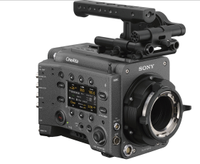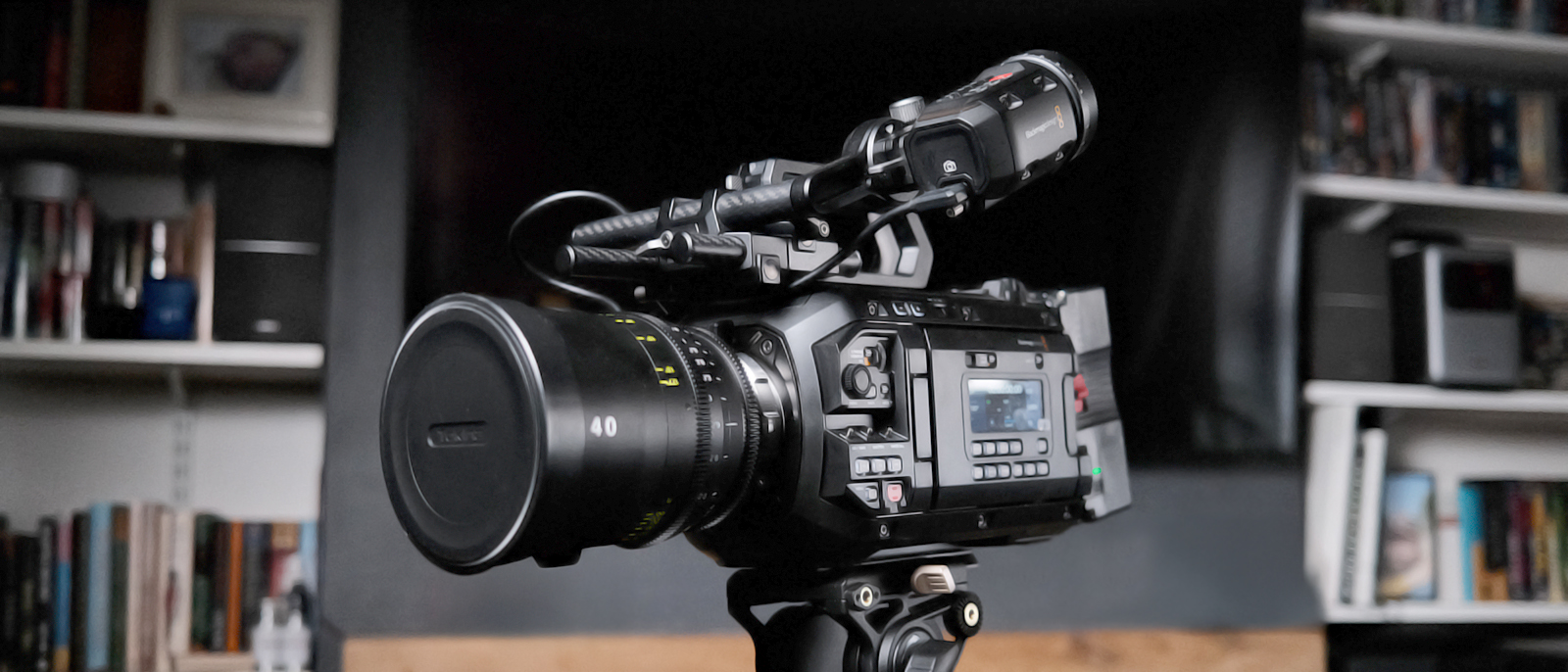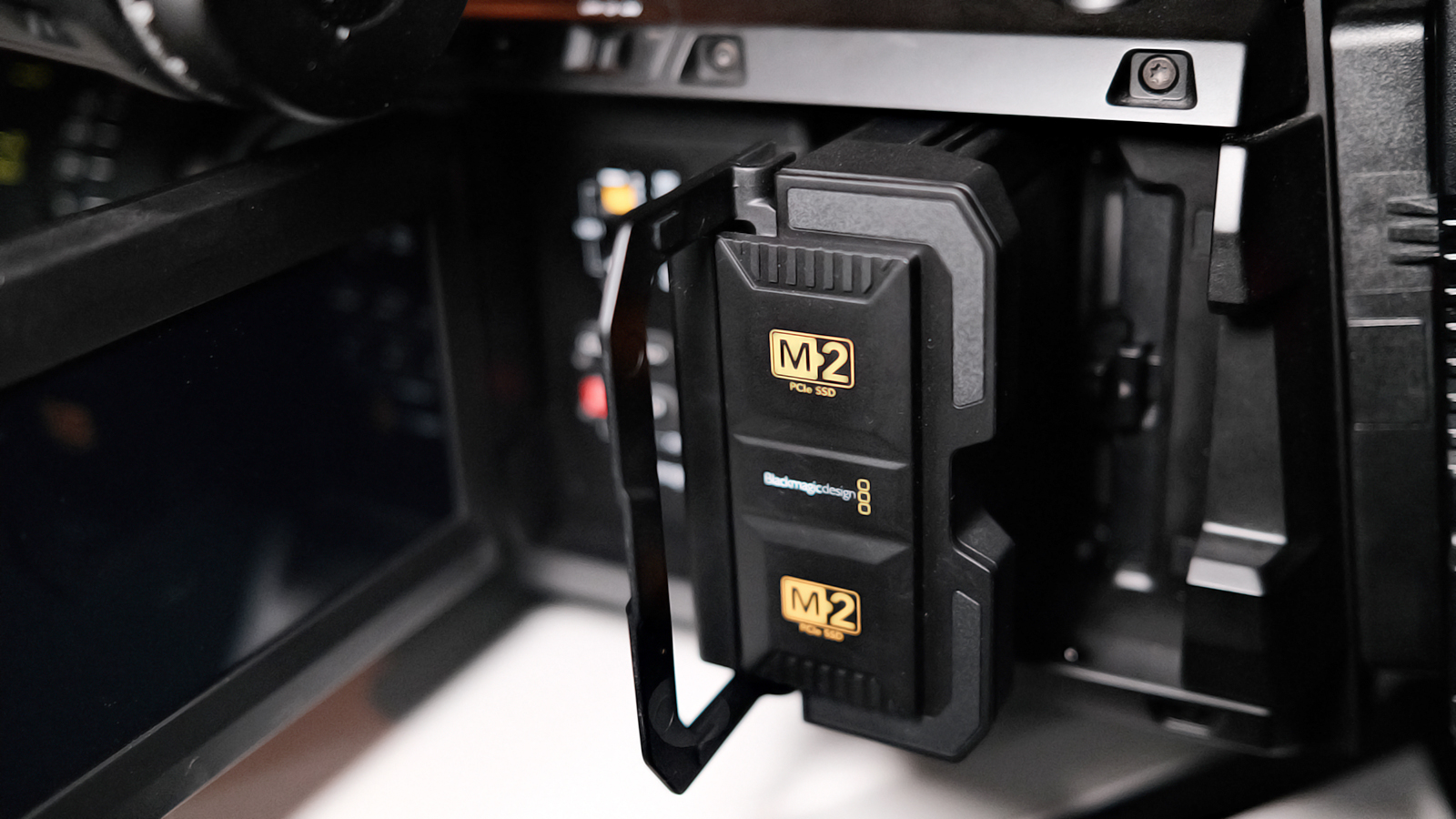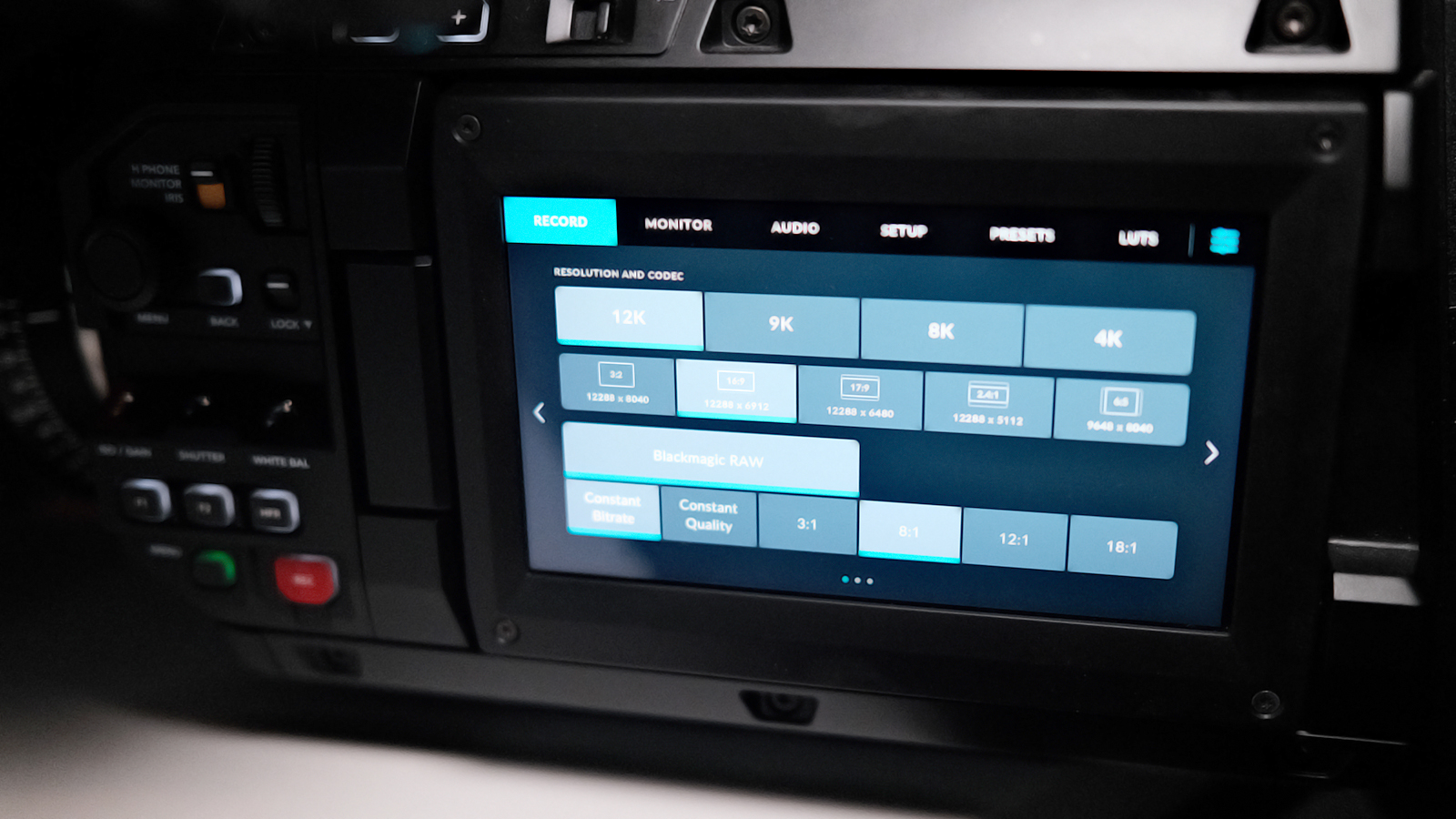Digital Camera World Verdict
The Usa Cine 12K LF is a powerhouse of a camera. It has a full complement of features, connections for days and, most importantly, captures beautiful images. It’s best suited to controlled environments but will handle just about anything you throw at it.
Pros
- +
Beautiful imagery
- +
Excellent UI
- +
No sensor cropping at lower resolutions
- +
AC side monitor
Cons
- -
High storage demands
- -
Needs protection from the elements
Why you can trust Digital Camera World
Blackmagic Design seems to be one of the few camera companies forging new ground in the cinema camera space, pushing not just resolution but trying new technologies, and the Ursa Cine 12K LF is the latest example of this. Aimed squarely at the filmmaking community, the Ursa aims to offer all the features you could need for capturing the best image, with all the trimmings for supporting it in that role.
I’ve rigged and shot with many cameras over the years, from DSLRs back in the day, numerous mirrorless systems, a whole range of cinema cameras, and have spent countless hours rigging and shooting in all manner of situations. I don’t believe there is a ‘best’ camera out there, only the best for you, or for a given task. The Ursa looks set to offer versatility, quality, and a form factor that allows it to excel in as many situations as possible, though, with a feature set that should deliver the goods.
But does it deliver? I’ve spent some time with it now, weighing up the pros and cons, focusing on everything from the form factor, image quality, rig integration, to the overall user experience.
URSA Cine 12K LF: Specifications
Sensor size | 35.64mm x 23.32mm |
Dynamic range | 16 stops |
Dimensions | 6” x 6” x 11” Body only |
Weight | 8.72lbs |
Frame rates | 23.98, 24, 25, 29.97, 30, 50, 59.94 and 60 fps, plus various high rates |
URSA Cine 12K LF: Price
The Ursa Cine 12k LF comes in a number of bundles/kits starting at $7,695 / £7014, which is a big investment, but it compares very favorably with other high-end cinema cameras. You get a lot of capability for your money, so even if 12K isn’t something you’ll be delivering, you still get a fantastic 4k and 8K camera, with a level of future proofing built in, alongside all the other benefits Blackmagic provides. I’m also a big fan of the peli cases these come with, with custom-cut inserts to keep everything safe and organised. Just remember to factor in the cost of things like media, plus you’ll need to ensure your supports can handle the size and weight. The price is good, though, and you can actually buy it, unlike certain members of the competition.
URSA Cine 12K LF: Design & Handling
The Ursa is a substantial piece of equipment which feels very well put together, from the finish to every screw, bolt, hinge and button. Although it takes its toll on the shoulder after a while, that weight can be beneficial, as it removes some micro jitters. A good thing, as cine cameras generally aren’t stabilised internally. That said, the size and weight mean you’ll want to use something like a good tripod or an easy rig, as it's just a bit too much for handheld work. With a battery, lens, and other add-ons, the weight will be somewhere around the 15 lbs plus mark.
If you’ve seen the photos, you’ll notice how the body looks very similar to the Ursa Mini Pro, and yes, style-wise, there is a shared design language. The Cine is larger and heavier, but also feels built to an even higher quality. Obvious differences are that the main LCD is a 5” option and bright enough to be used in daylight, plus the data screen on the outside is colour, which can aid in quickly checking things. Similarly, the buttons illuminate, often in various colours. For example, the ND filter buttons change colour so you know where you are at all times. I prefer this setup so much more than the older rotary knob they used to use.
Then, of course, there is that lovely large assistant’s monitor on the AC side of the camera, which is big, bright, and crisp, with its own set of buttons dedicated to functions an AC would benefit from, like editing slate data.
The best camera deals, reviews, product advice, and unmissable photography news, direct to your inbox!
IO is plentiful and covers all the bases. There's a 12G SDI, full-size XLR on the top rear (although I’m not a fan of the flappy cover, I’d much rather have a hinged lid) and a number of USB-C ports. One up front for sending power and data to the EVF or Pyxis monitor, and others for data. There is a DC power input, and under the fold-out monitor is the media bay. This can take either of Blackmagic’s media cartridges (more on this later). There’s a 7-pin LEMO port, timecode and reference ports, and a 10GB Ethernet port, plus twin wifi aerial ports on top.
Rigging points can be found up top and underneath. These are basic but serve the purpose of adding tripod plates, top handles, and the like. Because of that extra screen, there’s no space for a side plate or handle, but I don’t think that will be a problem for anybody looking at this camera. Keep in mind that cooling is handled by venting on the top and bottom, so you will want to keep these clear and also consider a rain hood to protect the internals, which are somewhat vulnerable out of the box.
I’ve been testing using Blackmagic’s top handle, which adds some rigging points on top, perfect for an easy rig release or another monitor. This handle is the same as the Pyxis, meaning it has slots for adding the EVF/monitor accessories. I don’t usually like being tied into what a manufacturer wants me to use, but the rod setup here is really good, so I’m happy. The rods are just right for adding my Nucleus motors. The setup allows for super fast adjustment of the EVF too, so when changing position, keeping shooting isn’t held up by tweaking the rig.
I was sent the PL version of the Ursa Cine; however, it is available as a locking EF or LPL too.
Overall, this makes a compelling package that is easy to use, as a single operator or as part of a team. An AC can very easily work on the extra screen, pulling focus, adding shooting, and so on. The colourfully illuminated buttons allow for an at-a-glance operation, although I find the record button placement to be awkward in certain positions. However, there’s another on the EVF which I find I use far more, along with the other function buttons found there. All the buttons can be locked with a small switch. A good safety net feature, but there’s no way to customise what gets locked or not that I could find, which is a shame but could be sorted in a firmware update.
With a B-mount battery and a lens, the rig ends up at 19” long. Not exactly a stealthy run and gun rig, but then the target audience for this type of camera will most likely not be worried by that.
URSA Cine 12K LF: Performance
Let’s start with that sensor. The Cine 12 can shoot 3:2 open gate, as well as anamorphic in a range of squeeze factors. Shooting open gate means no need for calculating crop factors, so focal lengths stay consistent, and you get the benefits of using the entire sensor. The sensor is large at around 51mm x 23mm, which is 65mm. The high pixel count means the pitch is rather small, and I had thought this might be detrimental to dynamic range, as well as introduce some noise, but the clever folk at Blackmagic have developed a new sensor layout which uses RGBW, with the ‘W’ handling gamma. The end result is a claimed dynamic range of 16 stops. I’m often cautious when it comes to manufacturers’ claims, but Blackmagic has always been pretty true to their word, and shooting on this, I’d say 16 stops is accurate.
That said, this is a camera that likes light. When testing ISO performance, I did find that lower ISO introduced noise fairly quickly; however, higher settings were much more forgiving.
Shooting at higher quality settings in camera, then downscaling in Resolve, will yield better results, but it’s good that you can take advantage of the full sensor and do it in camera, saving on some of the huge file sizes. That said, the Ursa still produces lovely results, and the lack of cropping or pixel binning is a big plus. No need to calculate how much of the frame you’re going to lose.
Now, the elephant in the room with a sensor so large is the size of the files. These can get pretty large, at around 1,194 Mbps data rate at the highest quality setting of 3:1 compression. This will clearly eat up media in no time, but you can address this using higher compression settings. At the max 18:1, you get 199mbps. The downside to this is that some obvious artefacts are present. They aren’t so obvious at 8:1 but become more so at 12:1 as you’d expect. The image is still very usable at these rates, but if you’re shooting content where detail is key, then you will want to invest in more storage. Zoom into a 12:1 frame, and you can see the lack in clarity around certain details, such as text or small foliage. The Cine 12K does deal with moire well, thanks to the inclusion of an optical low-pass filter that handles aliasing and pattern noise you see on things like fabrics or bricks. This works very well, and even zoomed in to a frame, there’s no evidence of these issues.
Storage itself comes in two flavours. You can use the CF Express caddy, but do check on which cards are supported, as with any other camera. Or opt for the M.2 drives, which are fantastic, although you can max these out pretty fast too. At the highest constant quality settings, you can shoot for over 2 hours, but that will fill 8TB. This can be drastically reduced, though. Use Q3, still open gate at 24fps, and you’ll get over 7 hours. Blackmagic has a handy calculator, making it easy to see what different balances of quality, speed, and storage could work for your needs.
Transferring these files is well catered for too. You can use wifi, a Blackmagic dock for the media caddies, or hook up via 10gig Ethernet, my preferred choice.
The Ursa Cine 12K also allows for proxies, on the fly, that can be uploaded to the Blackmagic Cloud, using wifi or even your phone, all at the same time as capturing your full quality footage.
Handling the footage in Resolve is surprisingly fast. My M4 Pro MacBook Pro handled everything well, and an older M1 MacBook didn’t seem too bothered by the files either. I did test some fusion comps, which were perhaps a little slower but not in any meaningful way, although this will, of course, depend on what you throw at it.
Now, there’s no global shutter on offer here, but don’t worry too much about rolling shutter. I have no way to test this to any degree of accuracy, but others have, and reports are around 12ms, which is pretty impressive and can be reduced further by using a lower resolution, without any cropping of the image. In my real-world tests, I found no significant jello effects at all, other than the fastest of pans, and even these can be countered in Resolve. Yes, it’s another step in the workflow, but not a big one, and for all the other benefits of this camera, something I can live with.
The Ursa CIne 12K runs Blackmagic’s latest gen 5 colour science, which is beautiful. The balance between detail, saturation, clarity, and contrast is excellent, producing really lovely images with the kind of highlight rolloff I really appreciate. That said, getting the most from your footage will mean doing some work in Resolve, navigating the very full lists of colour space transforms, but that’s something you only really need to nail once. The footage is endlessly tweakable with a lot of latitude. Correcting and then applying any styling is simple and allows for a colourist to really go to town. Likewise, for VFX shots, the bump in resolution to 12K should mean comp work, tracking, and so on are accurate too.
Now, back to the camera and its extra screen. This is a feature that I wish more cameras had. Even for solo shooters, it’s a real joy. The large, bright display is easy on the eye, at 1600nits with a sunshade. It gives quick access to add useful slate data and has some handy benefits for pulling focus. If your lens is compatible, you get matched focal distance and aperture scales, with markers. For team shoots, this is truly a useful feature, and even for the lone operator, it has its uses, especially when mounted on a tripod. It doesn’t articulate, however, unlike the main screen, which can be flipped, keeping things compact.
Blackmagic’s app can control the camera too, via Bluetooth and an iPad. This is handy not just for a hands-off approach but also for when the camera is mounted in an awkward position, say on a crane.
A note on operating. Blackmagic has hands down the cleanest, most intuitive user interface of any camera system. I can tolerate others, but actually enjoy the OS here. It’s nice to look at, logical, and never feels overwhelming. Applying different settings to the various outputs is a breeze, adjusting anything takes no more than a few clicks, and most can be done via buttons and switches if you prefer to work that way. The physical controls are great too. I really like the combination of encoders, buttons, and switches, which makes it easy to lock in muscle memory. Perfect for dimly lit locations.
With all this in mind, you’ll need a solid power source too. Luckily, you have plenty of choices here. The Ursa ships with a B mount battery plate, but there are options for V mount and gold mount plates, at very reasonable prices, making it easy to adapt to your preference. It does come with a hefty 250-watt power supply too, perfect for those shooting indoors or with access to a generator on location. How much mileage you get from your setup will vary, with not just accessories being powered but also the type, capacity, and age of your batteries, as well as ambient temperature. For sending power elsewhere, there are standard Lemo and Fischer connectors, as well as USB-C ports, ideal for keeping your phone powered for streaming and offloading proxies.
One last thing to keep in mind is your lens choice. There’s no point having a 12K sensor if your glass isn’t capable of resolving that detail as well as providing coverage for the sensor size. My testing was done using Tokina Vista primes, which turned out to be a perfect match. For many, this will be a case of lens rentals, but if you have already invested in glass, make sure your choices play nicely together.
I wanted to test the real-world results of the various compression settings, so I set up a very simple scene, with just two lights. Lots of contrast, some skin tones, various textures, and so on, then recorded using both 12K and 4K, using all the different compression settings. Dropping them on a HD timeline, as that is still how so much content is delivered. I did a simple colour correction and colour space transform, which is the same across all the clips. I'm amazed at how little difference there is in the end results, and this shows not just how good BRAW is but also demonstrates the in-camera downsampling. Yes, the differences would be far more obvious on a 12K timeline, but the actual use case for that is negligible. For now.
URSA Cine 12K LF: Verdict
The Ursa Cine 12K is a powerhouse of a camera. Operation is a joy, although make sure the size and weight are suited to your needs. The picture is beautiful, even at higher compression settings, thanks to BRAW, and there are plenty of options to manage quality vs file size. Yes, media may be expensive, but that’s going to be the case for any camera with these kinds of data rates, and you can mitigate that depending on the project you’re shooting. Handling the files is less of a headache than you might imagine, even on older machines, plus the proxy system is ace. Blackmagic has hit a real home run with the Cine 12K. It produces images comparable to cameras that cost significantly more and pairs seamlessly with Resolve (which you would expect).
Features ★★★★★ | The Ursa Cine 12K has just about every feature you could want, from a full range of IO, to built-in NDs, various media options and wifi connectivity. |
Design ★★★★☆ | Although partly personal I’d suggest the design of the Ursa is excellent. Everything falls to hand nicely, the UI is fantastic and operation is easy from both sides. It is a little on the beefy side though. |
Performance ★★★★★ | The Ursa Cine 12K excels in most regards. Image quality is exceptional, the operating system is very responsive and it’s pretty good on power usage too. |
Value ★★★★★ | It’s a large chunk of cash but if you’re in the market for a camera of this type, it’s a worthy investment. It’s pretty futureproof and adaptable to lots of shooting scenarios. |
✅ Buy it...
- Resolution and quality top your list of requirements
- You appreciate a clean simple user experience
🚫 Don't buy it...
- If you need a small light package
Alternatives

Sony Venice: It may ‘only’ have 6K, but it’s a fantastic camera, well established in the filmmaking community.

Rob is Editor of ImagineFX magazine and also works as creative director for his own studio, Pariah Studios, producing 3D animation, film and VFX for a variety of clients.
He started his career as a photographer, slowing adding 3D, film and visual effects and film into his toolbag, working across TV, web and print, with clients ranging from Blackmagic Design and HMV to Games Workshop and Royal Mail.
When not on at his desk he can be found building and playing guitars or out in the wilderness with his dog.
You must confirm your public display name before commenting
Please logout and then login again, you will then be prompted to enter your display name.









